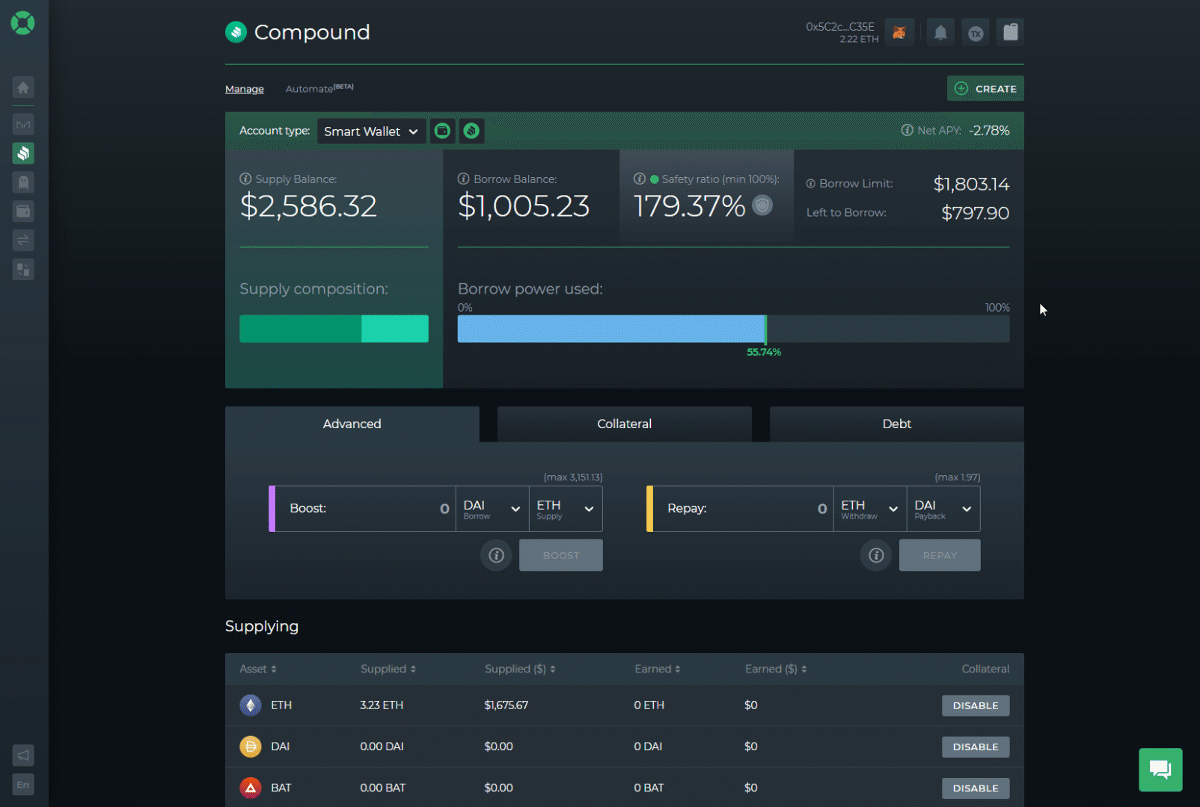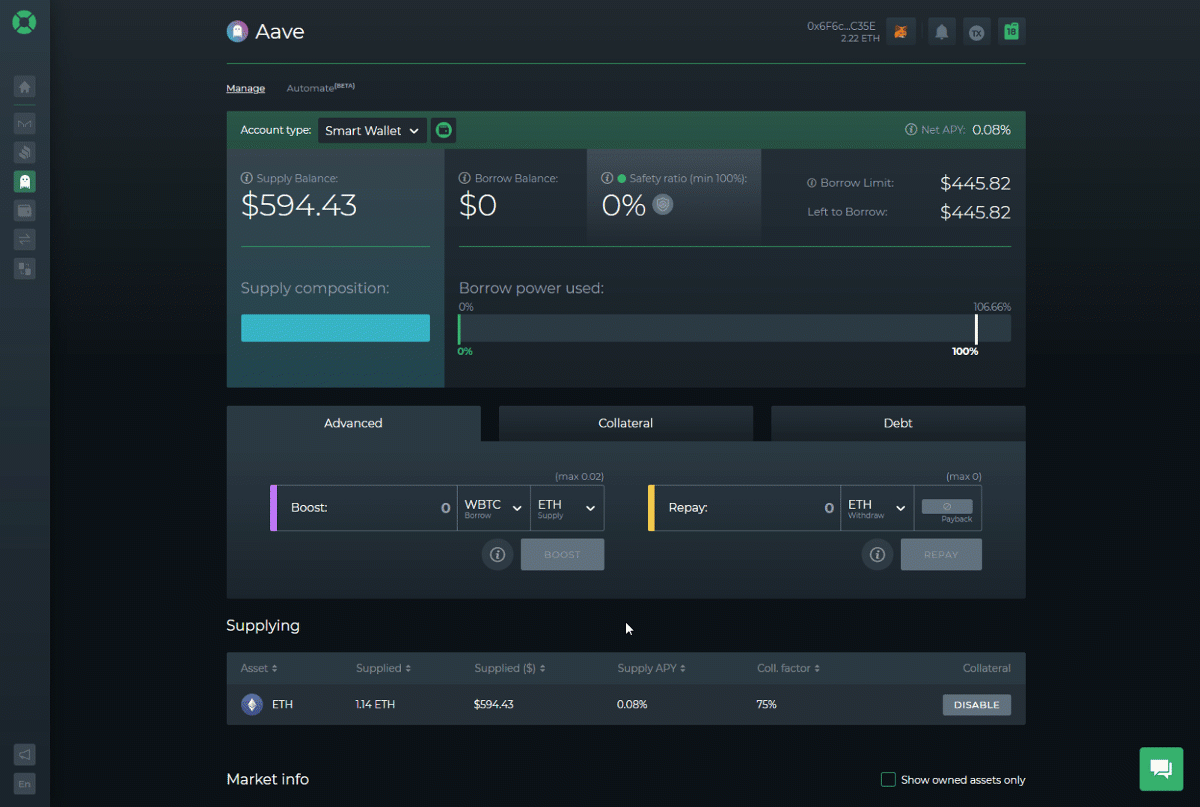How to long (or short) the ETH-WBTC ratio
A guide on longing or shorting asset ratios using Compound or Aave.📊

⚠️Before we jump into this guide I want to highlight that this should be considered an advanced trading strategy as leveraging around two volatile assets can get risky much quicker than just leveraging ETH or WBTC against a stablecoin. There’s no way to have a clear liquidation point you can keep track of when both assets’ prices are constantly moving. Please use it carefully.
We talked about creating a long or short position around any single asset supported by the most popular DeFi lending protocols in a recent article, but with the crypto markets heating up, the option to create a leveraged position around a ratio of two assets might also become interesting to many.
The goal of creating a leveraged position is simple — to be able to close it out later with a greater balance of assets than what you started with.
The concept for achieving this is relatively simple and either the value of your supplied asset needs to grow compared to those you borrowed, or the value of the borrowed asset needs to go down compared to those supplied.

For example, if you believe that ETH will outperform WBTC over a certain period, you would want to create a long ETH-WBTC position to benefit from that. This is something that would be done by supplying ETH, borrowing WBTC, and then additionally using the borrowed WBTC to obtain more ETH for leverage.
In this case, your position would become profitable by either ETH going up in value quicker than WBTC, or WBTC dropping in value quicker than ETH. The most beneficial scenario would be for ETH to move up, while WBTC drops, but don’t forget that the complete opposite could happen too, putting you in a very unfavorable spot.
Specifically, let’s say you have 64 ETH to start with and let’s imagine that 1 ETH is currently worth $500, while 1 WBTC is $18,000. At that point you can create a leveraged position where you borrow 1 WBTC and use it to obtain additional ETH, making your total collateral amount 100 ETH. Your total supply at this point is $50,000 and your debt is $18,000.
Now, if ETH were to move up by 20% to $600, while WBTC only moves up by 5,5% to $19,000 this will result in your collateral value growing to $60,000 and your debt being at $19,000. At this point you can pay off your total debt with ~31.6 ETH, putting your ETH balance at 68.4 — a nice 4.4 ETH (or 6.8%) increase.
In this example specifically, the ETH-WBTC ratio would have grown from 0.027 to 0.031 and you would have successfully “longed it” and captured a profit.

It’s worth highlighting that this is a concept that can be applied to any two assets. You just need to supply the asset that you believe will perform better and that you want “to long”, while borrowing the asset you believe will perform poorer. For example, if you want to long the LINK-MKR ratio, you would want to create a position where you supply LINK and borrow MKR.
Now, with the theory covered, let’s see how one can actually go about creating a long or short position for the ETH-WBTC ratio.
Setting up using Compound
Creating a long ETH-WBTC position at Compound is extremely simple if using DeFi Saver.
If you go to the Compound dashboard, you will see the Create position option in the top right which will allow you to configure your wanted leverage level and have everything set up for you in one single transaction.
(Note that these new assets, supplied ETH and borrowed WBTC, would be added to your current Compound portfolio if you already have assets in Compound.)

When you decide it’s time to close this position (be it to take profits or prevent losses if you see markets moving in opposite directions of what you predicted), you can use our Repay feature which will use the supplied ETH to pay off the WBTC debt, after which you would be able to withdraw the remaining ETH balance.
Setting up using Aave
Alternatively, if you want to go with Aave this process currently takes two steps instead of one, as we’re currently waiting for the Aave v2 release to roll out more Aave-focused features.
Specifically, if you wanted to long the ETH-WBTC ratio, you would need to supply ETH and then Boost the WBTC/ETH pair. Boosting does the borrow (WBTC), swap (WBTC->ETH) and supply (ETH) steps all in one transaction.

Similar to Compound, when you decide it’s time to close out the position you can use our Repay option to pay off the WBTC debt using collateralized ETH.
Considerations on using Compound vs Aave
For the most part, you wouldn’t notice much difference between these two options when it comes to using either ETH or WBTC.
Most importantly, in terms of ETH and WBTC, they have the same collateral factors (max LTV) in both protocols:
- ETH: 75% collateral factor / LTV
- WBTC: 60% collateral factor / LTV
However, if you would like to leverage around different assets, this is where Aave would probably be the better choice. While Compound supports ETH, WBTC, COMP, UNI, ZRX and BAT, Aave further expands that list with YFI, LINK, MKR, SNX, REN, MANA, KNC and ENJ (though there’s no COMP support at Aave as of now).

Additionally, there are two more important differences to consider and those are the potential point of liquidation, as well as the liquidation penalty.
When using Compound, the max LTV ratio is also the liquidation point, but this is not the case in Aave. Whereas the collateral factor for ETH and WBTC in Aave is 75% and 60% respectively, the liquidation thresholds are slightly higher at 80% and 65% for those two assets.
While this difference isn’t really big, it does translate into slightly lower chances of getting liquidated in Aave.
And, finally, another important difference is the actual liquidation penalty (or the discount for liquidators, depending which way you look at it). While it’s currently fixed at 8% for all assets at Compound, it’s variable at Aave and it’s 5% for ETH, but as high as 15% for WBTC.
You can find more info on liquidation mechanisms in DeFi in our recent post on how different liquidation processes work. Or if you’re specifically looking for Aave liquidation factors, those are available on their risk parameters page.
Final notes
As mentioned right at the beginning, leveraging around a ratio of two volatile assets should be considered an advanced strategy. Things are a lot simpler and easier to keep track of when one side of the position has a fixed value (ie. when it’s a stablecoin).
One of the options to protect your position against liquidation and unwanted losses are our Automation services which are available both for Compound and for Aave.
As always, if you have any concerns or questions in general about any of this, please feel free to join the DeFi Saver discord server.
We hope you found this useful and see you soon with more insightful posts! 😉
Stay connected:
🌍: DeFiSaver.com
💬: Official Discord
📢: Official Twitter



